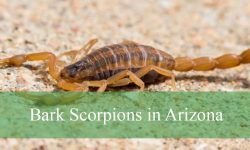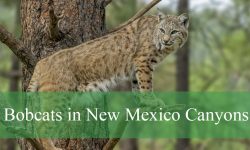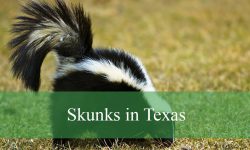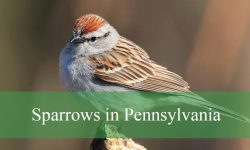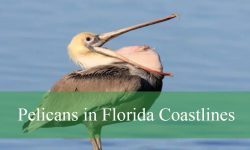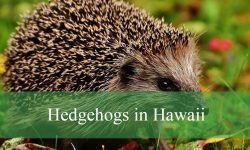Whenever I step outside in Indiana, I’m always amazed by the variety of birds I encounter. From the bright red Northern Cardinal singing on my porch to the chatter of Blue Jays in the nearby trees, each bird adds its own unique charm to the day. Birdwatching has become more than a hobby—it’s a way for me to connect with nature right in my backyard.
On one weekend hike, I decided to focus on identifying the birds around me. It was incredible how many familiar faces I spotted—American Robins hopping on the lawn, Mourning Doves cooing softly in the bushes, and even a flashy American Goldfinch darting through the garden. Each species has its own story and behavior that makes watching them truly rewarding.
In this guide, I’ll share my favorite 46 common birds in Indiana, complete with clear photos and identification tips. Whether you’re a seasoned birder or just starting out like me, you’ll find useful insights to help recognize and appreciate these feathered neighbors throughout the year.
Common Birds Found in Indiana
American Goldfinch
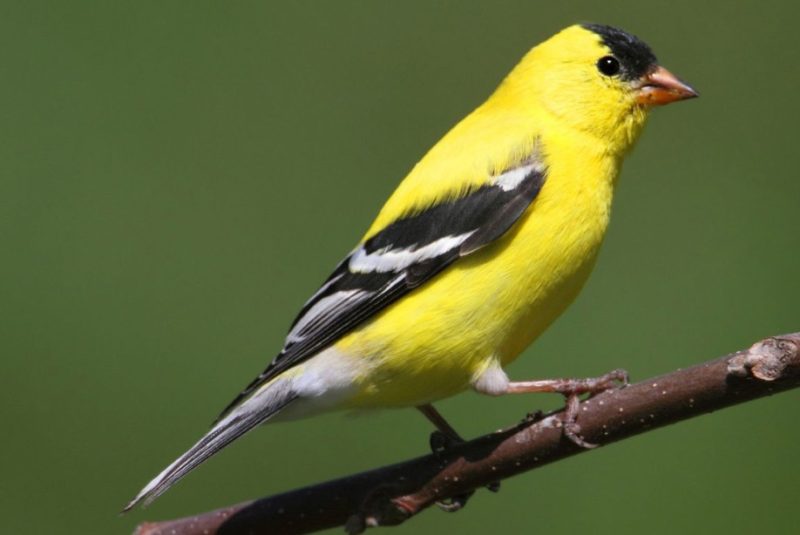
The American Goldfinch is a small, vibrant songbird with a cheerful personality and a fondness for open fields and gardens. Males in breeding plumage are a brilliant lemon yellow with a black cap, black wings, and a white-tipped tail, while females and non-breeding males are more subdued in yellowish-brown tones. Their short, conical bills are perfect for extracting seeds from thistles, sunflowers, and other plants.
These birds measure around 4.3 to 5.1 inches in length with a wingspan of 7.5 to 8.7 inches, making them smaller than most common backyard birds. Their flight is distinctive, featuring an undulating pattern where they alternate between rapid wingbeats and short glides. The American Goldfinch is notable for its sweet, musical song and call notes, often described as “per-chick-o-ree,” which they sometimes repeat while flying.
In Indiana, American Goldfinches are found year-round in weedy fields, meadows, orchards, and suburban areas. They are one of the few bird species that molt into bright breeding plumage in late spring rather than early spring, timing their nesting to coincide with the peak availability of seeds in mid- to late summer. Their adaptability to both wild and human-influenced environments ensures they remain a common sight across the state.
Northern Cardinal
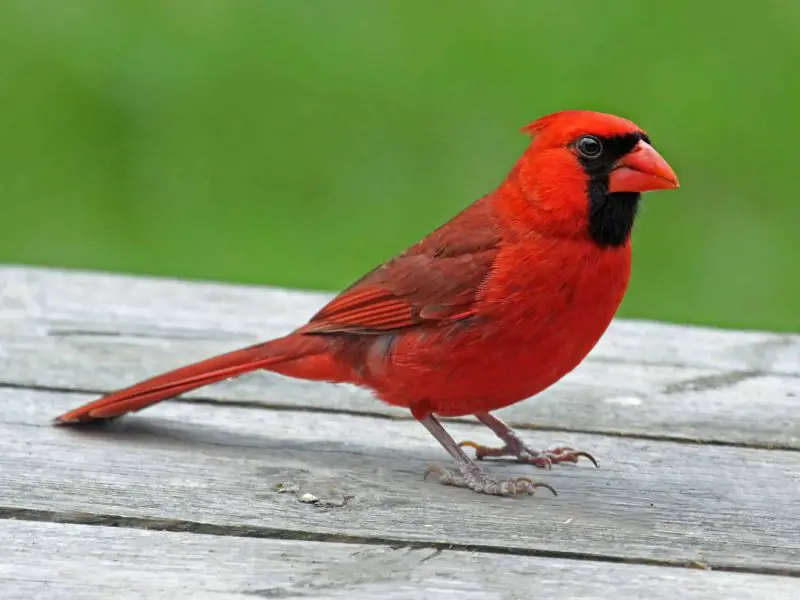
The Northern Cardinal is one of Indiana’s most recognizable and beloved birds, easily identified by its striking plumage and strong presence in both urban and rural settings. Males are a vivid crimson red with a black mask around the bill, while females have a warm brownish-tan body accented with subtle red tinges on the wings, tail, and crest. Both sexes feature a sharp crest atop the head and a thick, orange-red conical bill, which is perfectly adapted for cracking seeds. Their bright coloration and bold posture make them stand out in any season, especially against the snow in winter.
In terms of size, the Northern Cardinal measures about 8 to 9 inches in length with a wingspan ranging from 9 to 12 inches. Their calls are clear, whistled notes, often sounding like “cheer-cheer-cheer” or “birdie-birdie-birdie,” and both males and females sing, which is unusual among North American songbirds. Cardinals are generally non-migratory, remaining in Indiana throughout the year. They are territorial during the breeding season, with males often fiercely defending their space from rivals.
Northern Cardinals inhabit a variety of environments, including backyards, woodland edges, shrublands, and city parks. In Indiana, they are widespread and thrive in areas with dense shrubs or low trees, which provide both nesting cover and a steady food supply. They feed mainly on seeds, fruits, and insects, often visiting backyard feeders stocked with sunflower seeds. Their adaptability to human-altered landscapes has made them one of the most common and enduring bird species in the state.
American Robin
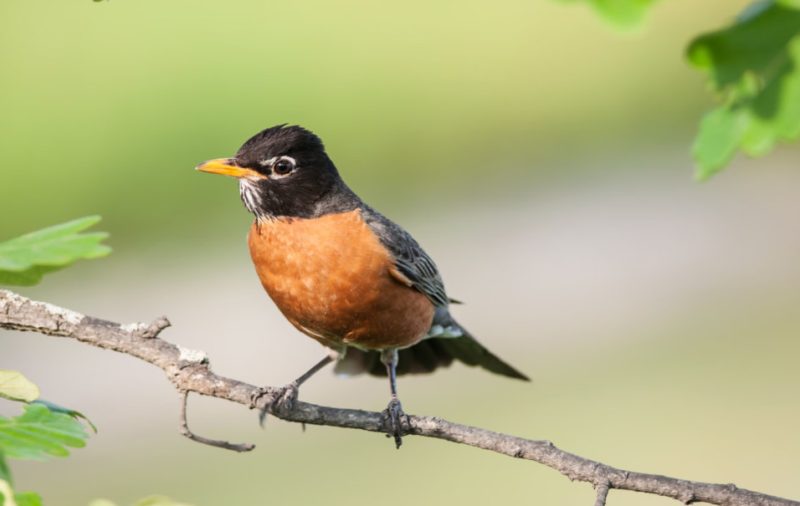
The American Robin is a familiar sight across Indiana, known for its warm reddish-orange breast, dark gray back, and white underparts. It has a medium-length tail with white corners and a yellow bill that often shows a faint dark tip. In flight, robins display strong, steady wingbeats, and their upright stance on the ground makes them easy to recognize. Males tend to have slightly brighter plumage than females, though both sexes share the same general markings.
Measuring around 9 to 11 inches in length with a wingspan of 12 to 16 inches, the American Robin is larger than many backyard songbirds. Their song is a cheerful, whistled series of phrases that sounds like “cheerily, cheer up, cheer up, cheerily, cheer up,” often heard at dawn and dusk during the breeding season. Robins are highly active and spend much of their time hopping across lawns or open fields in search of earthworms and insects. In fall and winter, they shift to a diet rich in berries and fruits.
In Indiana, American Robins are year-round residents, though northern populations may migrate south during the coldest months. They occupy a wide range of habitats including woodlands, gardens, farmlands, and urban areas. Robins build cup-shaped nests out of grass and mud, often in trees, shrubs, or on building ledges. Their adaptability, willingness to live near humans, and distinctive behaviors have made them a symbol of springtime across the state.
Mourning Dove
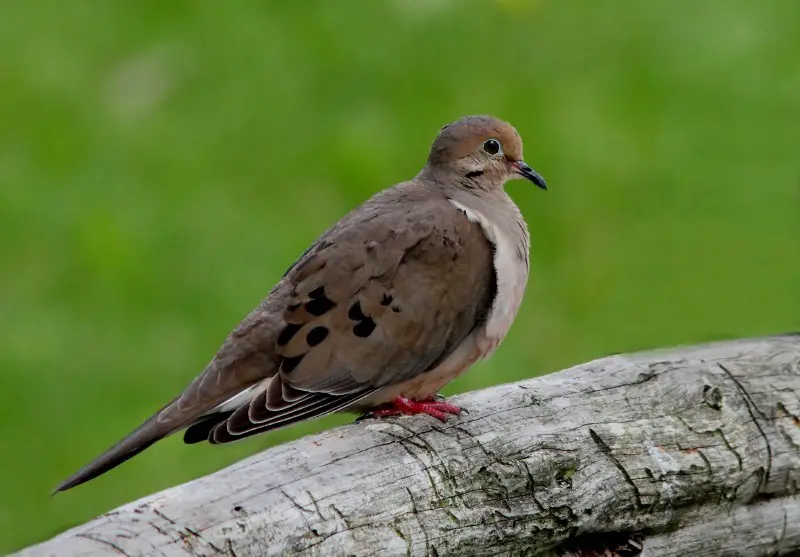
The Mourning Dove is a graceful bird with soft beige-brown plumage, black spots on the wings, and a long, pointed tail edged in white. Its small head, slender body, and gentle dark eyes give it an elegant appearance. The name “Mourning Dove” comes from its distinctive, mournful cooing call, which is often heard in the early morning and evening hours. Their streamlined shape and rapid wingbeats make them swift and agile flyers.
Mourning Doves are medium-sized, measuring about 9 to 13 inches in length with a wingspan of 17 to 18 inches. In flight, they produce a distinctive whistling sound with their wings, particularly during takeoff and landing. They primarily feed on seeds, which they forage on the ground in open spaces, and will readily visit backyard feeders offering millet or cracked corn. These birds are also known for their strong pair bonds, often seen in mated pairs even outside the breeding season.
In Indiana, Mourning Doves are common year-round, inhabiting open fields, grasslands, roadsides, and suburban areas. They nest in trees, shrubs, or even on building ledges, creating flimsy platforms of twigs. Their adaptability to different environments and prolific breeding—producing several broods per year—ensure their steady presence across the state. They are also a popular game bird during hunting season, though their numbers remain stable due to high reproductive rates.
Blue Jay
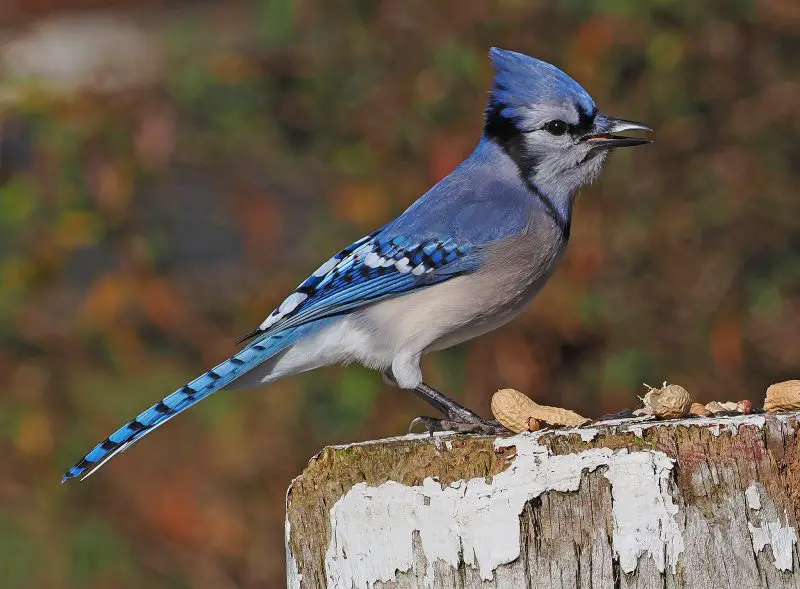
The Blue Jay is a bold and intelligent bird, instantly recognizable by its bright blue upperparts, white underparts, and black necklace-like markings across the chest. Its crest can be raised or lowered depending on mood, often standing tall when the bird is excited or alarmed. Blue Jays also have striking white wing bars and a patterned tail, making them particularly eye-catching in flight.
Measuring about 9 to 12 inches in length with a wingspan of 13 to 17 inches, the Blue Jay is one of the larger songbirds found in Indiana. Known for their loud calls, they produce a variety of vocalizations, including harsh “jay-jay” cries and complex whistles. Blue Jays are also excellent mimics, sometimes imitating the calls of hawks. Their diet is varied, consisting of acorns, seeds, nuts, insects, and occasionally small vertebrates. They are known for caching food for later use, especially in autumn.
Blue Jays inhabit forests, woodland edges, and suburban neighborhoods throughout Indiana. They are especially common in areas with oak trees, as acorns are a major food source. Although they can be aggressive toward other birds at feeders, they play an important role in seed dispersal, helping regenerate forested areas. Their strong presence and striking coloration make them one of the most charismatic birds in the state.
Downy Woodpecker
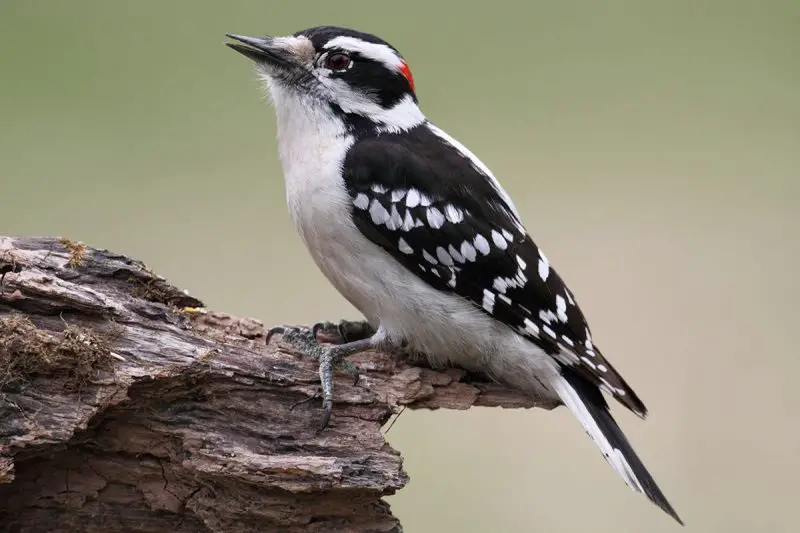
The Downy Woodpecker is the smallest woodpecker in Indiana, easily identified by its black-and-white plumage and small, compact body. Males have a small red patch on the back of the head, while females lack this marking. Their wings display a checkered pattern, and they have bold white stripes down the back. The short, chisel-like bill is proportionally smaller than that of other woodpeckers, which helps distinguish them from similar species like the Hairy Woodpecker.
Measuring about 5.5 to 6.7 inches in length with a wingspan of 9.8 to 11.8 inches, the Downy Woodpecker produces a sharp “pik” call and a rapid drumming sound during courtship or territory defense. They forage by tapping along tree trunks and branches, searching for insects, larvae, and eggs hidden beneath the bark. They also eat seeds and suet, making them frequent visitors to backyard feeders.
In Indiana, Downy Woodpeckers inhabit deciduous forests, orchards, parks, and residential areas with mature trees. They nest in tree cavities, often excavating their own nesting sites in dead wood. Their ability to thrive in both wild and suburban landscapes ensures they remain one of the most common and easily observed woodpeckers in the state.
Red-bellied Woodpecker
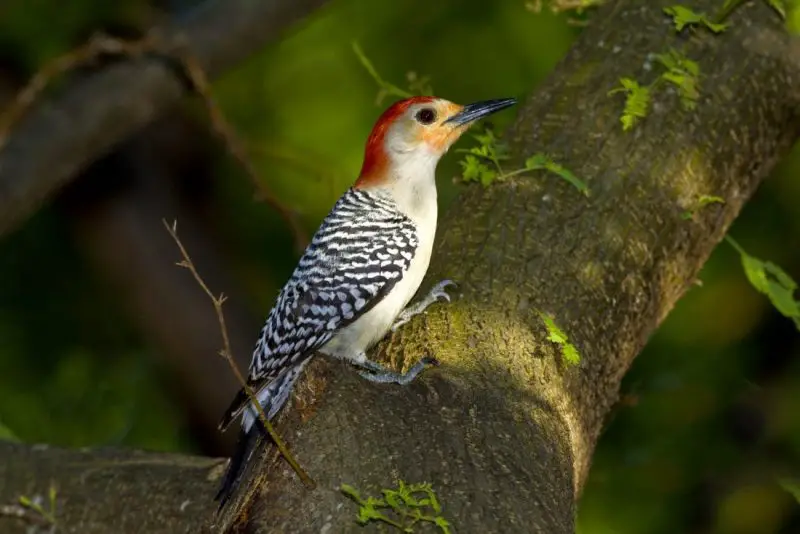
The Red-bellied Woodpecker is a medium-sized bird with a striking appearance, featuring a pale, lightly barred back and wings, a reddish wash on the belly, and a vivid red crown and nape in males. Females have a red nape and crown only at the back of the head. Their black-and-white barred pattern gives them a distinctive “zebra-backed” look. Despite the name, the red on the belly is often faint and not always visible.
They measure 9 to 10.5 inches in length with a wingspan of 13 to 17 inches. Their calls are a rolling “churr” or “kwirr” sound, and they are known for drumming loudly on hollow branches or poles. Red-bellied Woodpeckers have a varied diet, feeding on insects, fruits, seeds, and occasionally small vertebrates. They are also known to store food in tree crevices for later consumption.
In Indiana, they are common year-round residents, occupying woodlands, forest edges, and suburban areas with mature trees. They nest in tree cavities, which they excavate themselves. Adaptable and curious, Red-bellied Woodpeckers often explore new feeding opportunities, including visiting backyard feeders stocked with peanuts, suet, and sunflower seeds.
White-breasted Nuthatch

The White-breasted Nuthatch is a small, agile bird with a clean white face and underparts, a blue-gray back, and a black or dark gray cap that extends down the nape. Males tend to have a glossier black crown, while females have a duller grayish cap. They are unique in their ability to climb headfirst down tree trunks, using their strong feet and sharp bills to search for food.
Ranging from 5.1 to 5.5 inches in length with a wingspan of 7.9 to 10.6 inches, White-breasted Nuthatches have a nasal “yank-yank” call and a high degree of acrobatic skill. They primarily feed on insects and spiders during the warmer months, switching to seeds and nuts in winter. They often wedge large seeds into bark crevices and hammer them open with their bills.
In Indiana, these birds are found year-round in mature deciduous forests, wooded suburbs, and parks. They nest in natural tree cavities or old woodpecker holes, often lining them with fur or feathers. Their adaptability and distinct foraging behavior make them a favorite among backyard birdwatchers.
Black-capped Chickadee
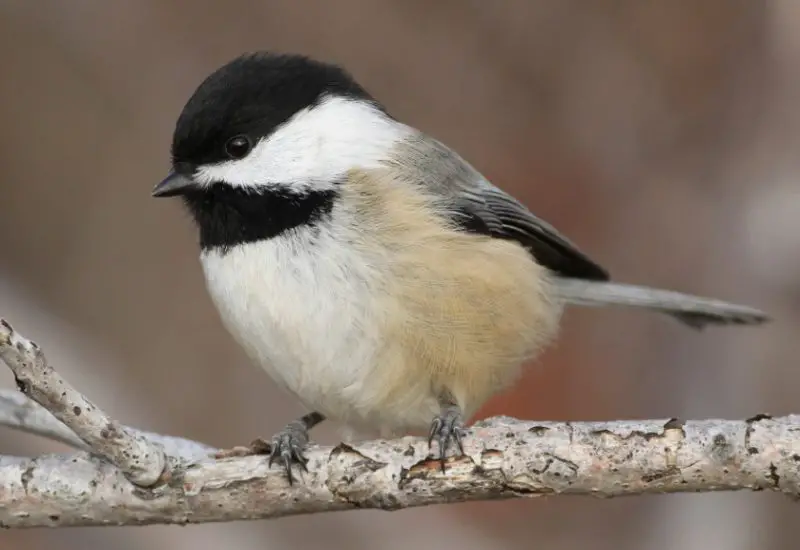
The Black-capped Chickadee is a small, energetic songbird known for its distinctive black cap and bib, white cheeks, and soft gray back. Its petite size and round body give it a charming appearance, and it often seems curious around humans. The tail and wings have subtle white edging, adding to its delicate look.
Measuring 4.7 to 5.9 inches in length with a wingspan of 6.3 to 8.3 inches, this species is named for its signature “chick-a-dee-dee-dee” call, which can vary in intensity depending on perceived threats. They are active foragers, flitting among branches in search of insects, spiders, seeds, and berries. Black-capped Chickadees are also known for caching food in hidden spots for later use, an important survival strategy in winter.
In Indiana, they inhabit mixed and deciduous forests, shrubby areas, and suburban backyards. They nest in tree cavities or old woodpecker holes, sometimes using nest boxes. Their year-round presence and friendly nature make them one of the most recognized and appreciated small birds in the state.
House Finch
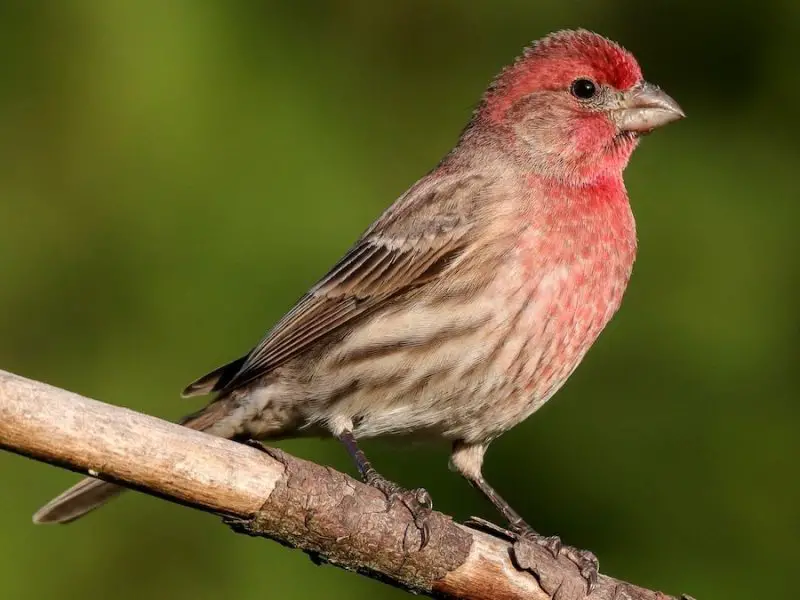
The House Finch is a small songbird with a slightly curved bill and a long, notched tail. Males display rosy-red coloring on the head, throat, and chest, which blends into streaked brown underparts, while females are entirely streaked brown without any red. Their plumage varies slightly depending on diet and region, but their cheerful song is a constant identifier.
House Finches measure 5 to 6 inches in length with a wingspan of 8 to 10 inches. Males sing a rapid, musical warble, while both sexes produce a sharp “cheep” call. They feed primarily on seeds, buds, and fruits, often foraging in flocks during the non-breeding season. House Finches are highly adaptable and are frequent visitors to backyard feeders stocked with sunflower seeds.
In Indiana, they are found year-round in urban areas, farmlands, and open woodlands. They often build nests in trees, shrubs, building ledges, or hanging planters. Their adaptability to human environments has allowed them to spread widely, making them a familiar sight in both cities and rural communities across the state.
Song Sparrow
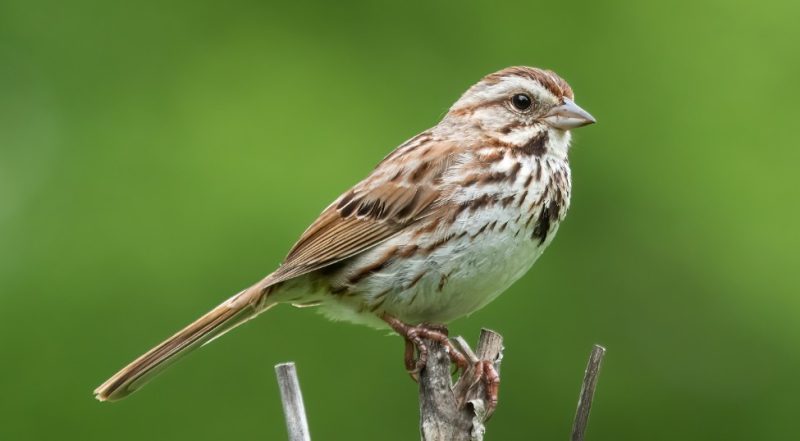
The Song Sparrow is a medium-sized bird with a streaked brown back, heavily marked breast, and a distinctive central dark spot on its chest. Its rounded head, long tail, and sturdy, conical bill give it a compact but alert appearance. Plumage varies slightly among individuals, but the combination of streaking and the chest spot makes it easy to recognize. Their rich, melodious song, composed of a few clear notes followed by a jumble of trills, is a familiar sound in Indiana’s spring and summer.
Measuring 4.7 to 6.7 inches in length with a wingspan of 7.1 to 9.4 inches, Song Sparrows are active foragers, scratching through leaf litter or hopping along the ground in search of seeds and insects. They are adaptable, often blending into their surroundings thanks to their earthy brown coloration. Males sing from prominent perches to defend their territories, and their vocal variations can differ greatly between regions.
In Indiana, Song Sparrows are found year-round in a variety of habitats, including open fields, marsh edges, hedgerows, and residential gardens. They build cup-shaped nests low to the ground in shrubs or tall grasses. Their ability to thrive in both rural and suburban areas ensures they remain a common and widespread species across the state.
House Sparrow
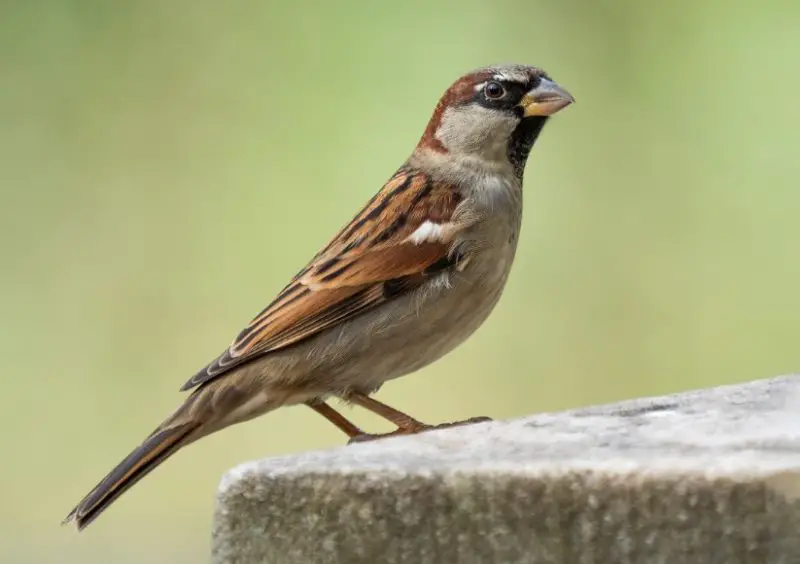
The House Sparrow is a stocky, social bird with a stout bill and short legs, well adapted to life near humans. Males have a gray crown, chestnut nape, black bib, and white cheeks, while females are plain brown with lighter underparts and a pale eyebrow stripe. Though not native to North America, they have become one of the most widespread and familiar birds in Indiana.
Ranging from 5.9 to 6.7 inches in length with a wingspan of 7.5 to 9.8 inches, House Sparrows are often noisy and active, producing a series of cheeping calls. They feed on seeds, grains, and scraps from human activity, and they are frequently seen hopping around sidewalks, parking lots, and outdoor eating areas. These sparrows are also aggressive competitors for nesting sites, often displacing native species.
In Indiana, House Sparrows are found year-round in cities, towns, farms, and anywhere people live or work. They nest in cavities, building eaves, vents, and nest boxes, lining their nests with grasses, feathers, and other soft materials. Their close association with humans ensures they remain abundant, though they are sometimes considered invasive due to their impact on native bird populations.
Eastern Bluebird
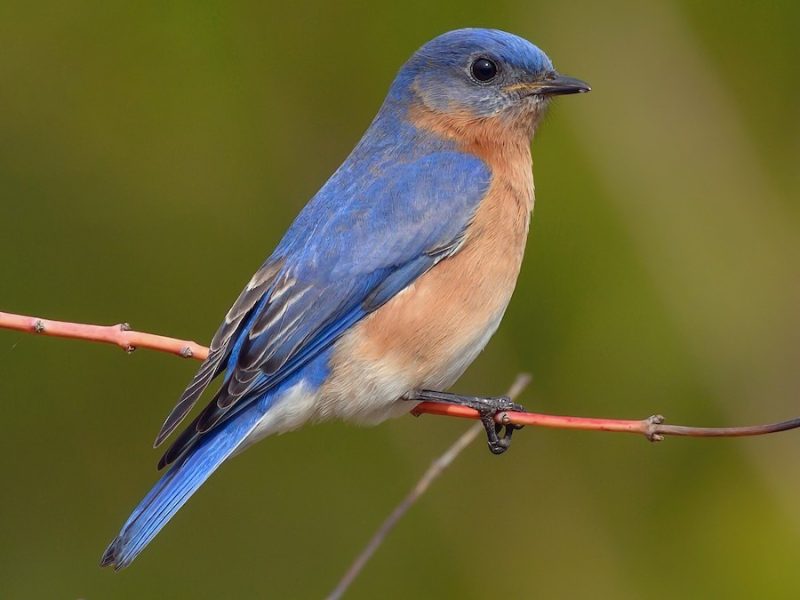
The Eastern Bluebird is a striking species, with males showcasing bright blue upperparts and a warm reddish-orange chest that contrasts with their white belly. Females have more subdued grayish-blue wings and tail, with a paler orange wash on the breast. Their gentle expression and vibrant colors make them one of Indiana’s most cherished birds.
Measuring 6.3 to 8.3 inches in length with a wingspan of 9.8 to 12.6 inches, Eastern Bluebirds have a soft, musical warble and a series of short “cheer” or “chur-lee” calls. They primarily feed on insects such as beetles, caterpillars, and grasshoppers during the warmer months, shifting to berries and fruits in the winter. Their hunting style often involves perching on low branches and swooping down to capture prey on the ground.
In Indiana, Eastern Bluebirds inhabit open fields, meadows, orchards, and the edges of wooded areas. They readily use nest boxes, which has helped their populations recover after past declines due to habitat loss and competition. Year-round residents in much of the state, they are especially visible in spring and summer when raising young in tree cavities or provided nesting structures.
Carolina Wren
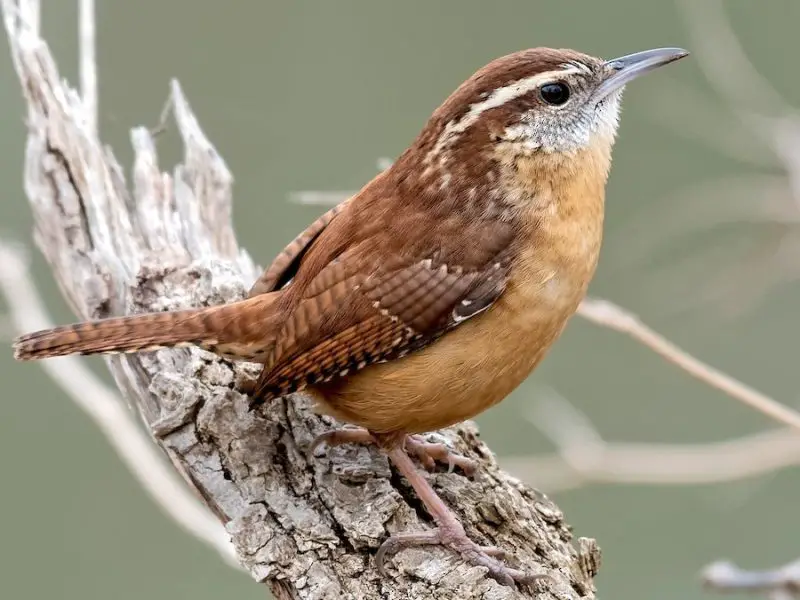
The Carolina Wren is a small but spirited bird with warm reddish-brown plumage, a bold white eyebrow stripe, and a slightly curved bill. Its tail is often held upright, and its short wings and rounded body give it a compact shape. Despite its size, this bird has a loud, ringing song often described as “teakettle-teakettle-teakettle.”
At 4.7 to 5.5 inches in length with a wingspan of 11 inches, Carolina Wrens are active and curious, frequently exploring shrubs, woodpiles, and other nooks for insects and spiders. They also eat seeds and fruits, particularly in winter. Their behavior is energetic and they are often seen hopping and flicking their tails while foraging close to the ground.
In Indiana, Carolina Wrens are found year-round, primarily in dense brush, forest edges, and suburban gardens. They build dome-shaped nests in cavities, crevices, or even unusual spots like mailboxes or flowerpots. Their adaptability and bold personality make them a favorite backyard visitor, especially when suet or mealworms are available.
Tufted Titmouse

The Tufted Titmouse is a small, lively bird with soft gray upperparts, a pale face, and a rusty wash on the flanks. Its prominent crest and large, dark eyes give it an alert and expressive look. The short, stout bill is suited for cracking seeds, while its agile movements help it forage efficiently among branches.
Measuring 5.5 to 6.3 inches in length with a wingspan of 7.9 to 10.2 inches, the Tufted Titmouse has a whistled “peter-peter-peter” call that is often heard before the bird is seen. They are acrobatic foragers, feeding on insects, seeds, nuts, and berries. Like chickadees, they store food for later use, tucking seeds into bark crevices.
In Indiana, Tufted Titmice are year-round residents, inhabiting deciduous forests, woodland edges, and suburban neighborhoods. They nest in tree cavities or use old woodpecker holes, lining them with soft materials such as moss, fur, and feathers. Their adaptability and charming behavior make them a frequent and welcome sight at backyard feeders.
European Starling
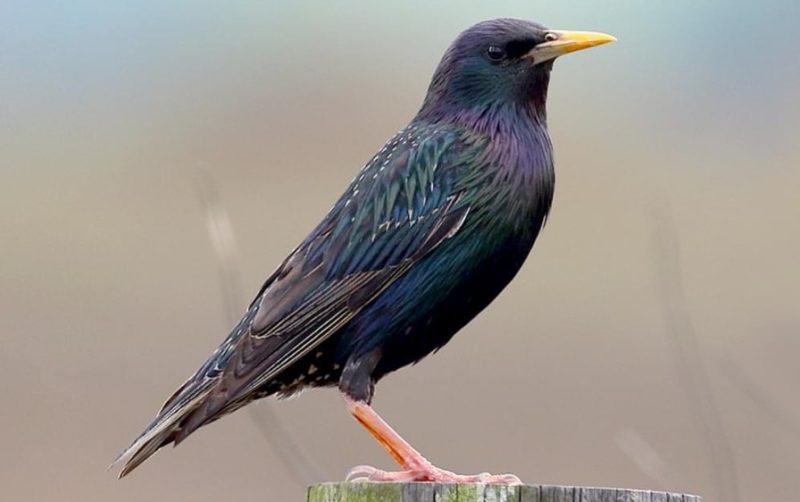
The European Starling is a medium-sized bird with glossy black plumage that shimmers with purple and green iridescence in sunlight. In winter, their feathers are speckled with white spots, while in summer the plumage appears more uniform and sleek. They have a pointed yellow bill during the breeding season, which turns darker in winter, and short triangular wings that make them agile fliers.
Measuring 7.9 to 9.1 inches in length with a wingspan of 12 to 16 inches, European Starlings are excellent mimics, capable of imitating the calls of other birds, mechanical sounds, and even human noises. They are social and often gather in large, noisy flocks, particularly outside the breeding season. Their diet is varied, including insects, earthworms, fruits, and seeds, which they forage from lawns, fields, and urban spaces.
In Indiana, European Starlings are year-round residents, thriving in cities, suburbs, and agricultural areas. They nest in cavities, often competing aggressively with native species for nesting sites. Despite being non-native and sometimes considered invasive, their adaptability and striking plumage ensure they remain a common sight throughout the state.
Common Grackle
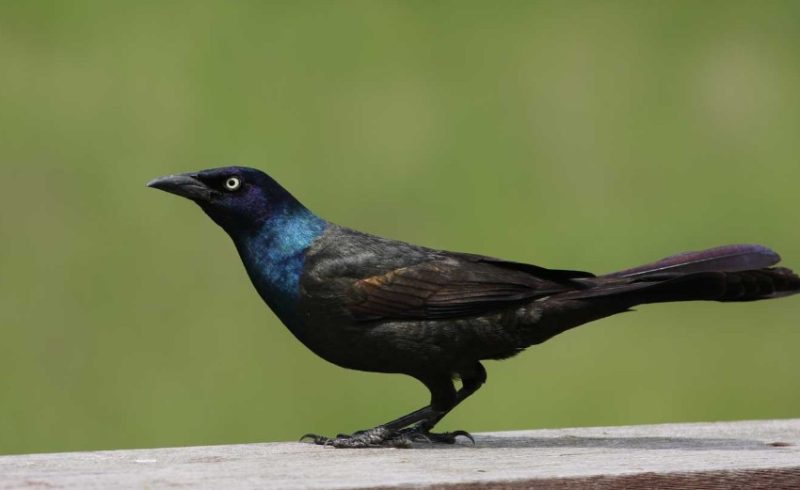
The Common Grackle is a large, lanky blackbird with an iridescent sheen, showing hints of purple, bronze, or green depending on the light. Its long, keel-shaped tail and pale yellow eyes give it a distinctive and somewhat intense look. The bill is long and slightly curved, well suited for its diverse diet.
Grackles measure about 11 to 13 inches in length with a wingspan of 14 to 18 inches. Their calls are loud and harsh, often described as metallic “creaks” or “squeaks.” They are opportunistic feeders, consuming insects, seeds, fruits, and even small vertebrates. These birds are known for their foraging in open areas, often walking on the ground with a confident stride.
In Indiana, Common Grackles are most numerous in the warmer months, though some remain year-round. They inhabit farmlands, marshes, open woodlands, and urban areas, nesting in colonies in trees or shrubs. Their adaptability to various habitats and social nature make them a frequent sight, especially in mixed flocks with other blackbirds.
American Crow
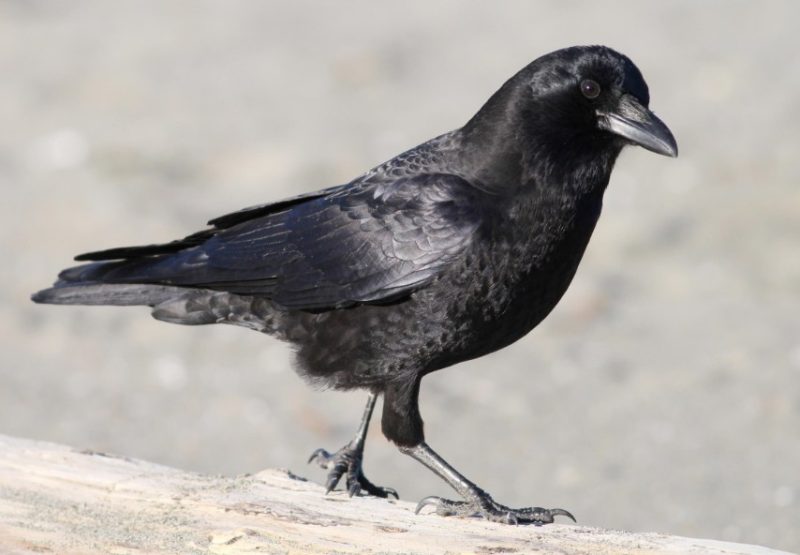
The American Crow is a large, intelligent bird entirely covered in glossy black feathers, including the bill and legs. Its plumage often shows iridescent purples and blues in bright sunlight. Recognized by its strong, steady flight and distinctive cawing calls, the crow is a familiar figure in both rural and urban landscapes.
Measuring 15.8 to 20.9 inches in length with a wingspan of 33 to 39 inches, American Crows are highly adaptable omnivores. They feed on insects, seeds, fruits, carrion, and even garbage in urban settings. Known for their problem-solving skills and memory, they have been observed using tools and recognizing individual human faces.
In Indiana, American Crows are found year-round across forests, farmlands, wetlands, and cities. They nest in tall trees, often returning to the same site year after year. Crows are social, forming large communal roosts in winter that can include thousands of individuals, creating a spectacular sight at dusk.
Dark-eyed Junco
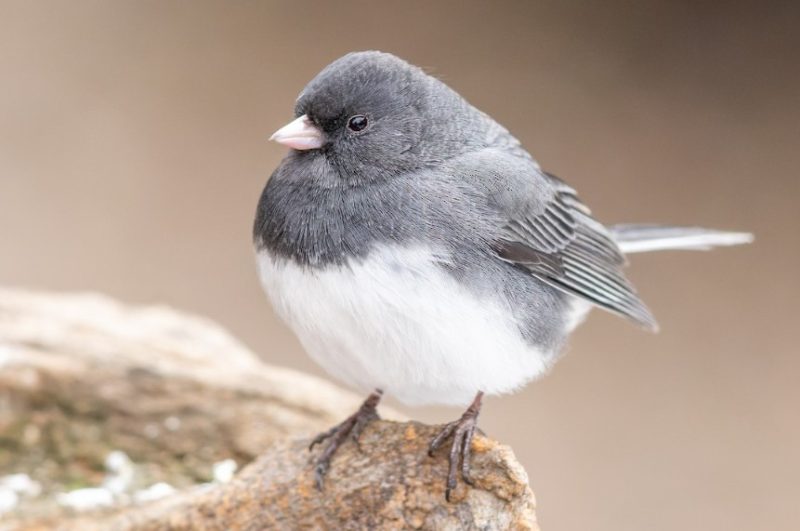
The Dark-eyed Junco is a small sparrow with a slate-gray head, back, and chest that contrasts with its white belly. Its pink bill and white outer tail feathers, which flash in flight, are key identification features. Females and juveniles tend to be browner overall, but the general color pattern remains consistent.
Ranging from 5.1 to 6.9 inches in length with a wingspan of 7.1 to 9.8 inches, Dark-eyed Juncos have a light, trilling song and sharp “tchip” calls. They feed primarily on seeds, supplemented by insects during the breeding season. On the ground, they hop or scratch in leaf litter, often in small flocks during migration and winter.
In Indiana, Dark-eyed Juncos are mainly winter visitors, arriving in large numbers in fall and departing by early spring. They favor open woodlands, fields, and backyard feeding stations, where they readily take millet and sunflower seeds scattered on the ground. Their arrival is often considered a sign of the changing seasons.
Northern Flicker
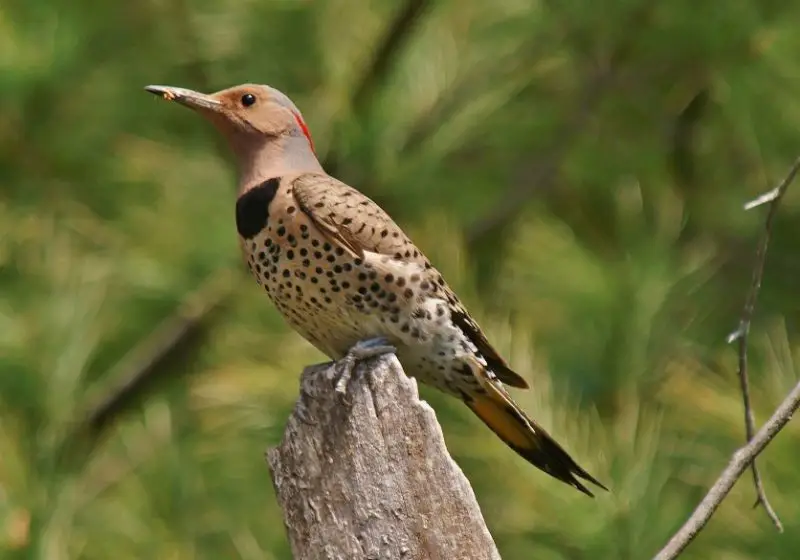
The Northern Flicker is a large, striking woodpecker with a brownish body patterned with black bars on the back and spots on the underparts. In Indiana, the “yellow-shafted” form is most common, showing bright yellow under the wings and tail. Males have a black mustache stripe, while both sexes display a white rump that is easily seen in flight.
Measuring 11 to 12.2 inches in length with a wingspan of 16.5 to 20 inches, Northern Flickers have a loud “wick-a-wick-a-wick” call and a distinctive undulating flight pattern. Unlike most woodpeckers, they often forage on the ground, probing for ants and beetles with their long, barbed tongue. They also eat fruits and seeds, especially in winter.
In Indiana, Northern Flickers are found in open woodlands, forest edges, parks, and large yards year-round. They nest in cavities they excavate in dead or decaying trees, occasionally using nest boxes. Their striking plumage and unusual feeding habits make them a standout among Indiana’s woodpecker species.
Chipping Sparrow
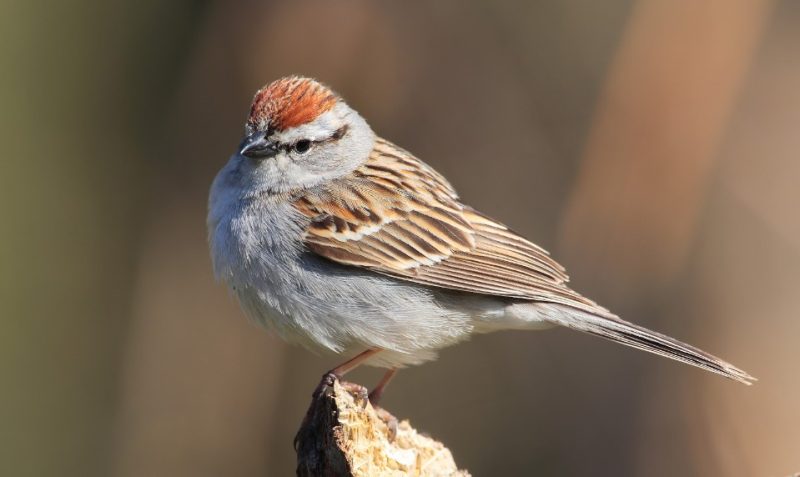
The Chipping Sparrow is a small, slender bird with a crisp appearance, especially in breeding season when adults show a bright rufous crown, white eyebrow, and black eye line. Their underparts are plain gray, and their back is streaked brown and black. In winter, their plumage becomes duller, with a brownish crown and more subdued facial markings.
Measuring 4.7 to 5.9 inches in length with a wingspan of 8.3 inches, Chipping Sparrows have a distinctive, rapid trilling song that sounds like a mechanical buzz. They primarily feed on seeds, especially from grasses and weeds, but switch to insects during the breeding season to feed their young. These sparrows often forage on the ground or low vegetation, sometimes in loose flocks.
In Indiana, Chipping Sparrows are common in open woodlands, grassy fields, parks, and suburban yards during the warmer months. Many migrate south in winter, though a few may remain in the southern part of the state. They build neat, cup-shaped nests in shrubs or trees, often returning to the same general area year after year.
Red-winged Blackbird
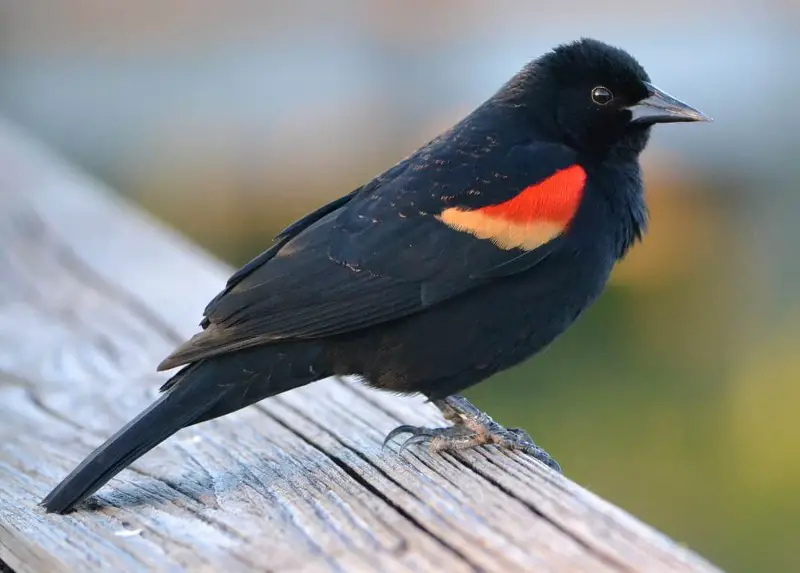
The Red-winged Blackbird is easily recognized by the male’s glossy black plumage with bright red and yellow shoulder patches, or “epaulets.” Females, by contrast, are heavily streaked brown with a pale eyebrow, resembling large sparrows. Males use their bold colors and loud songs to defend territories and attract mates.
Measuring 6.7 to 9.1 inches in length with a wingspan of 12.2 to 15.8 inches, Red-winged Blackbirds have a distinctive “conk-la-ree!” song that is a familiar sound in wetlands and fields. They feed on seeds, grains, and insects, often foraging in flocks outside the breeding season. Males can be aggressive defenders of their nesting territory, frequently chasing away intruders.
In Indiana, they are abundant during spring and summer in marshes, wet meadows, and roadside ditches. Some remain through the winter, particularly in the southern parts of the state. Their nests are usually woven into cattails or shrubs over water, offering protection from ground predators.
Brown-headed Cowbird
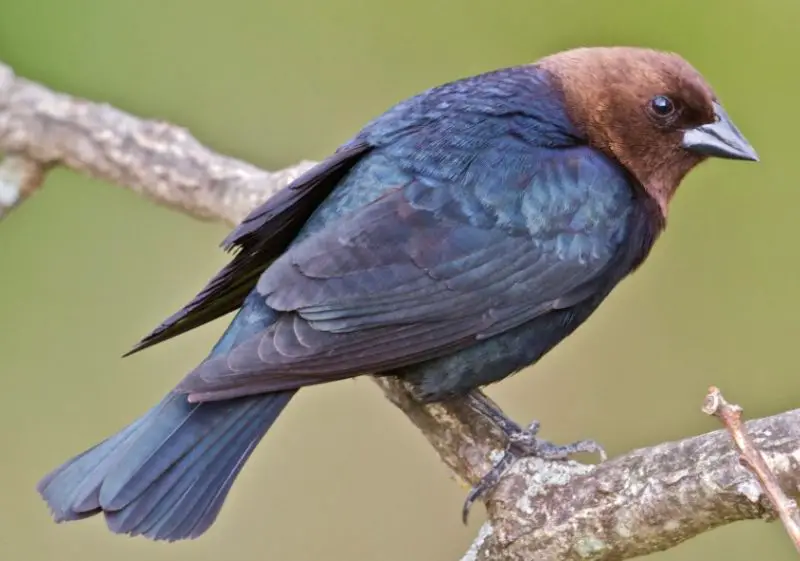
The Brown-headed Cowbird is a stocky blackbird with a short tail and thick, conical bill. Males are glossy black with a rich brown head, while females are plain gray-brown overall. They are best known for their unusual nesting behavior—they are brood parasites, laying their eggs in the nests of other bird species and leaving them to be raised by the unsuspecting hosts.
Measuring 6.3 to 8.7 inches in length with a wingspan of 12 to 15 inches, Brown-headed Cowbirds have a variety of whistles and gurgling calls. Their diet consists mainly of seeds and insects, and they often forage on the ground in open areas, sometimes among grazing livestock—a habit that originally led them to follow bison herds across the plains.
In Indiana, Brown-headed Cowbirds are common in open habitats, farmland, and suburban areas during the breeding season. They form large flocks in fall and winter, often mixed with other blackbirds and starlings. Their adaptability and feeding habits have allowed them to thrive across the state despite their reliance on other species for reproduction.
Barn Swallow
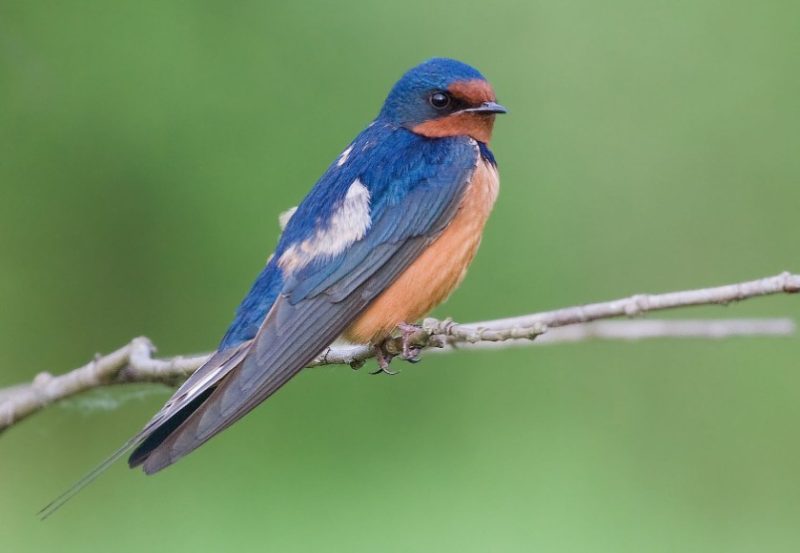
The Barn Swallow is a graceful, fast-flying bird with a deeply forked tail and long, pointed wings. Its upperparts are a glossy steel-blue, while the underparts are a warm buff to rufous color, and the throat is a rich reddish-brown bordered by a dark blue breast band. Their long outer tail feathers stream elegantly behind them in flight.
Ranging from 5.9 to 7.5 inches in length with a wingspan of 11.4 to 12.6 inches, Barn Swallows have a cheerful, twittering song and spend much of their time in aerial pursuit of flying insects. They are expert fliers, capable of quick turns and agile maneuvers as they hunt over fields, lakes, and open spaces.
In Indiana, Barn Swallows are summer residents, nesting under bridges, eaves, and inside barns or sheds. Their mud-and-grass cup nests are attached to vertical surfaces, often reused and repaired from year to year. They migrate to Central and South America for the winter, returning in spring to breed.
Eastern Towhee
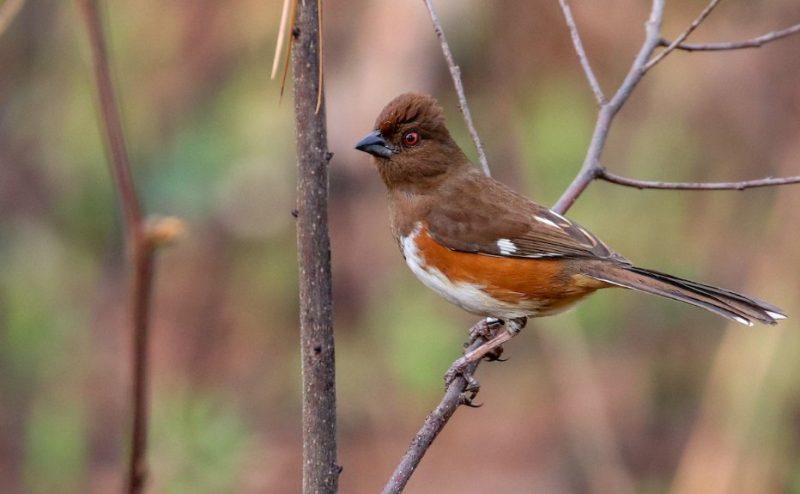
The Eastern Towhee is a striking, large sparrow with bold black upperparts, a rufous patch on the sides, and a white belly. Males have a black head, throat, and back, while females display the same pattern in warm brown. Both sexes have bright red eyes and a long tail with white corners that flash in flight.
Measuring 6.8 to 8.2 inches in length with a wingspan of 7.9 to 11 inches, Eastern Towhees have a sharp “drink-your-tea!” song and a distinctive “chewink” call. They forage mainly on the ground, scratching through leaf litter with a two-footed hop to uncover seeds, insects, and berries.
In Indiana, Eastern Towhees are common in shrubby habitats, woodland edges, and overgrown fields, especially during the breeding season. Some individuals remain year-round, particularly in the southern part of the state, while others migrate south for the winter. Their bold colors and lively calls make them a favorite among birdwatchers in the region.
Tree Swallow
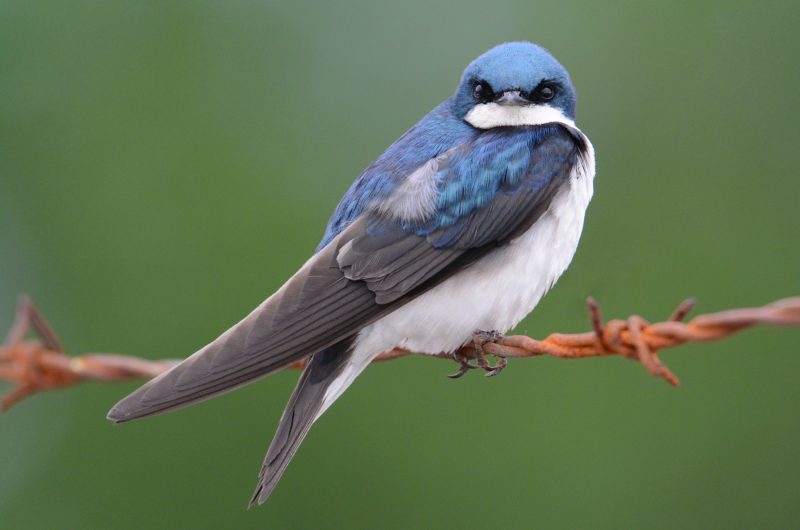
The Tree Swallow is a sleek, small songbird with shimmering blue-green upperparts, pure white underparts, and long, pointed wings. Their slightly forked tail and streamlined body make them highly agile in the air. Juveniles are duller, with brownish upperparts instead of the adult’s glossy plumage.
Measuring 4.7 to 5.9 inches in length with a wingspan of 11.8 to 13.8 inches, Tree Swallows are expert aerial insectivores, catching flies, mosquitoes, and other insects in swift, graceful flight. They have a soft, twittering song and are often seen in flocks swooping low over water or open fields. In colder weather, they will also eat berries, especially bayberries.
In Indiana, Tree Swallows are common summer residents, nesting in cavities such as old woodpecker holes or nest boxes near open water. They migrate to the southern United States, Mexico, and Central America for the winter. Their arrival in spring is a welcome sign of warmer days ahead.
Indigo Bunting

The Indigo Bunting is a small, vibrant songbird, with breeding males covered in dazzling, all-over blue plumage that glows most brightly in direct sunlight. Females and juveniles are warm brown with subtle streaking, which helps them blend into their surroundings. In low light, the male’s plumage can appear almost black.
At 4.7 to 5.1 inches long with a wingspan of 7.5 to 8.7 inches, Indigo Buntings are known for their sweet, double-noted songs that repeat steadily from exposed perches. They feed mainly on seeds and insects, gleaning from grasses and shrubs, and will visit backyard feeders offering millet or sunflower seeds.
In Indiana, Indigo Buntings are summer breeders, preferring shrubby edges, overgrown fields, and forest clearings. They migrate at night, traveling to Central America and the Caribbean for winter. The sight of a bright blue male singing from a treetop is one of the highlights of the state’s summer birdlife.
Great Blue Heron
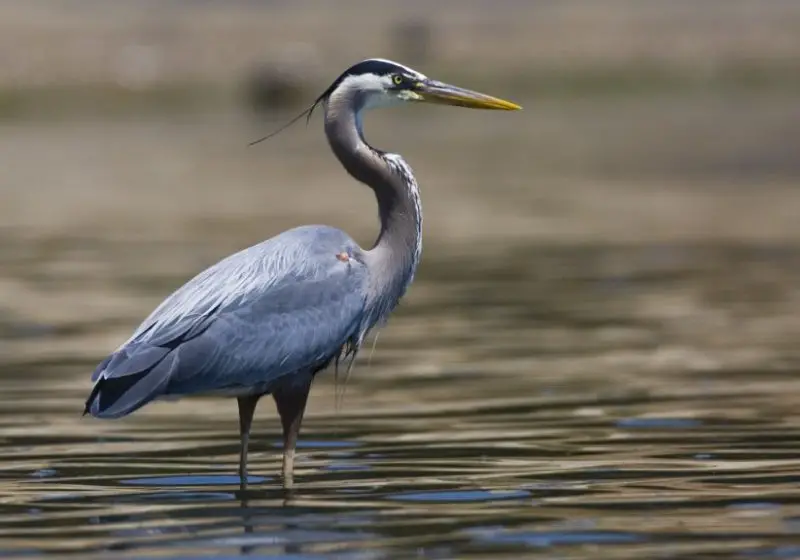
The Great Blue Heron is the largest heron in North America, with long legs, a long neck, and a sharp, dagger-like bill. Its plumage is mostly grayish-blue, with a black stripe over the eye and long plumes on the head, neck, and back. In flight, it tucks its neck into an S-shape, with slow, deep wingbeats.
Standing 38 to 54 inches tall with a wingspan of 65 to 79 inches, Great Blue Herons hunt by wading slowly through shallow water or standing motionless until prey—fish, frogs, or aquatic invertebrates—comes within reach. They strike with lightning speed, using their bill like a spear. Their deep, croaking call is often heard as they fly overhead.
In Indiana, Great Blue Herons are found year-round in wetlands, rivers, lakeshores, and ponds, though northern populations may migrate south in harsh winters. They nest in colonies called rookeries, often in tall trees near water, returning to the same sites for many years.
Eastern Kingbird

The Eastern Kingbird is a sturdy, medium-sized flycatcher with a dark gray back, white underparts, and a distinctive white band at the tip of its black tail. Its head appears large and blocky, giving it a bold, assertive look. During breeding season, it may display a small patch of red feathers on the crown, usually hidden from view.
Measuring 7.5 to 9.1 inches in length with a wingspan of 13 to 15 inches, Eastern Kingbirds are aggressive defenders of their nests, often chasing away much larger birds and even hawks. They feed primarily on flying insects, which they capture in short, direct flights from a perch. In late summer, they switch to eating fruits, particularly berries.
In Indiana, Eastern Kingbirds are summer residents, favoring open habitats like fields, orchards, and forest edges near water. They build bulky nests in trees or shrubs and migrate to South America for the winter, where they often feed in large flocks.
Gray Catbird
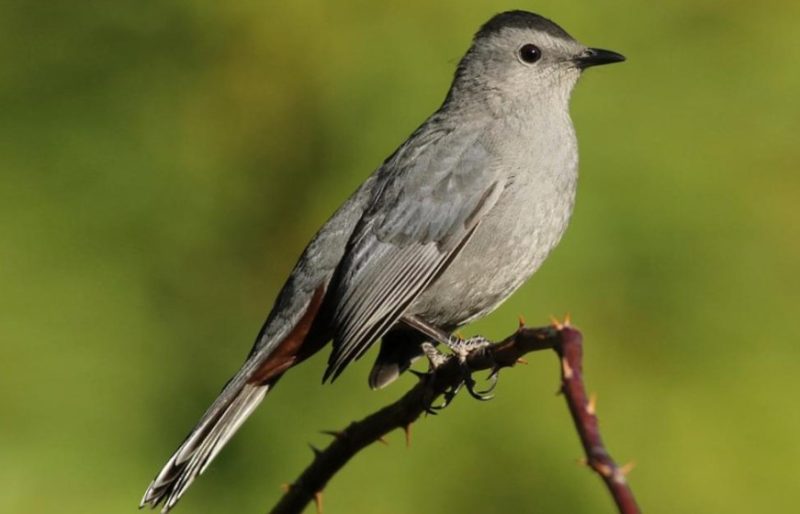
The Gray Catbird is a slender, medium-sized songbird with soft gray plumage, a black cap, and a distinctive rusty patch under the tail. Its name comes from its cat-like “mew” call, though it is also an excellent mimic, incorporating the songs of other birds into its own varied repertoire.
At 8.3 to 9.4 inches long with a wingspan of 11 to 12.2 inches, Gray Catbirds feed on insects, spiders, and a wide variety of fruits and berries. They forage both on the ground and in shrubs, often staying hidden in dense vegetation. Their song is a long, rambling mix of whistles, squeaks, and imitations.
In Indiana, Gray Catbirds are common in the warmer months, especially in thickets, forest edges, and suburban gardens. They migrate to the southern United States, Mexico, Central America, and the Caribbean for winter. Their vocal talents and curious behavior make them a delight for birdwatchers.
Cedar Waxwing
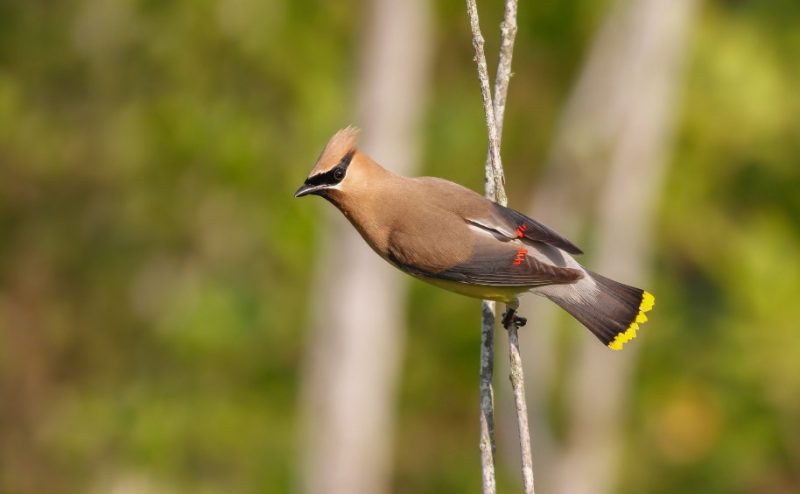
The Cedar Waxwing is a sleek, medium-sized songbird with silky brown plumage that fades to gray, a pale yellow belly, and a crest that often lies flat. Its most distinctive features include a black mask outlined in white, bright red waxy tips on the wing feathers, and a yellow band at the tip of the tail. These details give it a polished, almost regal appearance.
Measuring 5.5 to 6.7 inches in length with a wingspan of 8.7 to 11.8 inches, Cedar Waxwings are highly social and often travel in flocks. They feed primarily on fruits and berries, but also catch insects in midair, especially during summer. Their high-pitched trills and gentle calls are commonly heard before the flock is seen.
In Indiana, Cedar Waxwings can be found year-round, frequenting orchards, berry patches, forest edges, and suburban areas with fruiting trees. Their nomadic movements follow seasonal food availability, so their presence can vary from week to week.
Killdeer
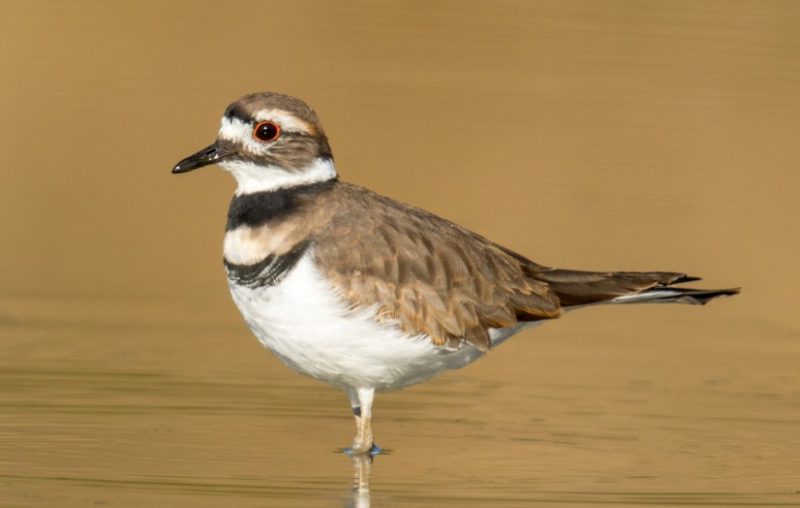
The Killdeer is a slender, long-legged plover with brown upperparts, white underparts, and two bold black breast bands. Its large eyes are set in a white face with a black line through the eye, and it has a long, pointed tail. In flight, a bright orange rump flashes, especially during alarmed takeoffs.
At 7.9 to 11 inches long with a wingspan of 18.1 to 18.9 inches, Killdeer are known for their loud, ringing “kill-deer” call, which gives them their name. They often use a “broken-wing” distraction display to lure predators away from their nests, which are usually shallow scrapes on the ground. Their diet consists mainly of insects and other small invertebrates, which they hunt in open areas.
In Indiana, Killdeer are common in fields, shorelines, golf courses, and gravel lots from spring through fall. Some remain through winter, especially in milder southern regions. Their adaptability allows them to thrive in both rural and urban landscapes.
Belted Kingfisher

The Belted Kingfisher is a stocky bird with a large head, shaggy crest, and a long, straight bill perfect for catching fish. Males have slate-blue upperparts, white underparts, and a single blue breast band, while females are more colorful with an additional rusty band across the belly.
Measuring 11 to 14 inches in length with a wingspan of 19 to 23 inches, Belted Kingfishers are often seen perched along rivers, lakes, and ponds, scanning for fish before diving headfirst into the water. Their rattling, mechanical call is a familiar sound near waterways. They nest in burrows dug into sandy banks, sometimes several feet long.
In Indiana, Belted Kingfishers are widespread around aquatic habitats from spring through fall, and many remain year-round where water does not freeze. They are solitary hunters, fiercely defending their fishing territories.
Great Horned Owl
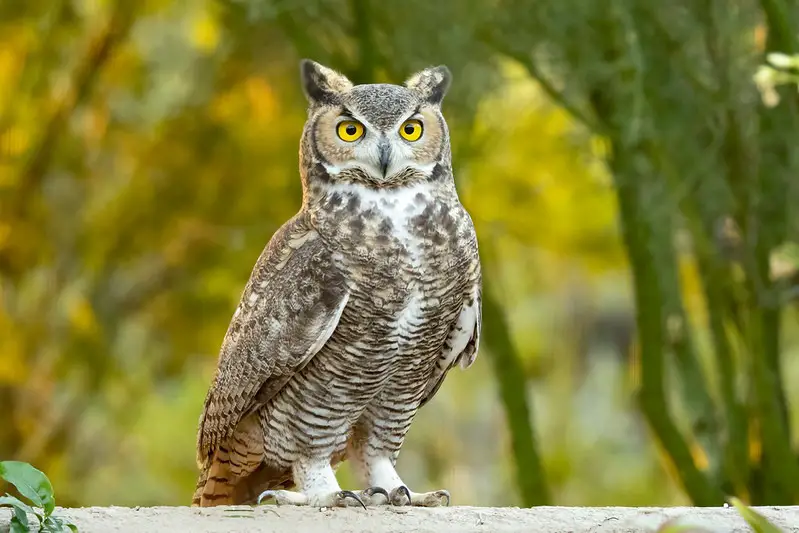
The Great Horned Owl is a large, powerful raptor with mottled brown and gray plumage, a white throat patch, and prominent ear tufts that give it a horned appearance. Its large yellow eyes and deep hooting call are iconic in North American woodlands.
At 18 to 25 inches in length with a wingspan of 39 to 57 inches, the Great Horned Owl is a formidable predator, capable of taking prey as large as rabbits, skunks, and even other birds of prey. Its strong talons and silent flight make it an efficient nighttime hunter. Pairs often duet with deep, resonant hoots that carry far through the night.
In Indiana, Great Horned Owls are year-round residents found in forests, farmlands, and even suburban parks. They begin nesting in late winter, often reusing old hawk or squirrel nests, making them one of the earliest breeders in the state.
American Kestrel
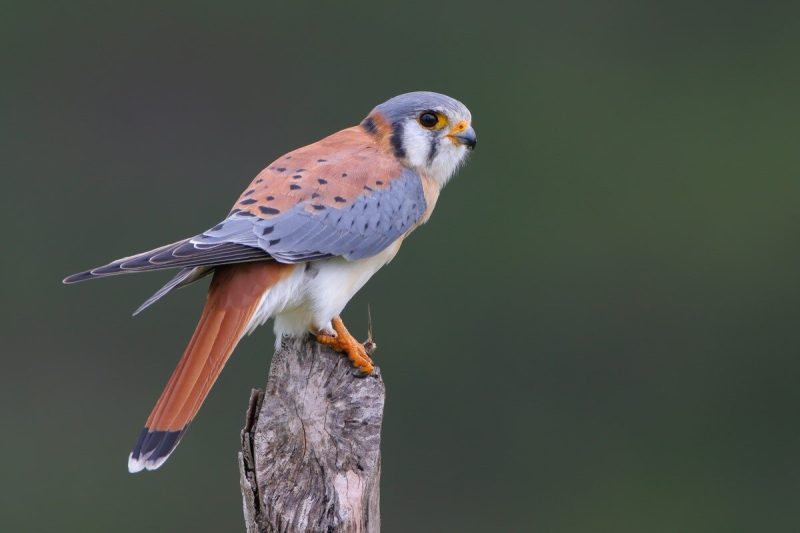
The American Kestrel is the smallest falcon in North America, with striking plumage and a delicate build. Males have blue-gray wings, rusty backs and tails, and black facial markings, while females are more uniformly rusty with black barring. Both sexes have sharp talons and a hooked bill for hunting.
Measuring 8.7 to 12.2 inches in length with a wingspan of 20 to 24 inches, American Kestrels often hunt from perches or by hovering in place over open ground, scanning for insects, small mammals, and birds. Their high-pitched “klee-klee-klee” call is distinctive.
In Indiana, American Kestrels are found year-round in open country, farmlands, and along roadsides. They nest in cavities, including nest boxes, and often use old woodpecker holes. While common, their populations have faced declines in some areas due to habitat loss.
Cooper’s Hawk
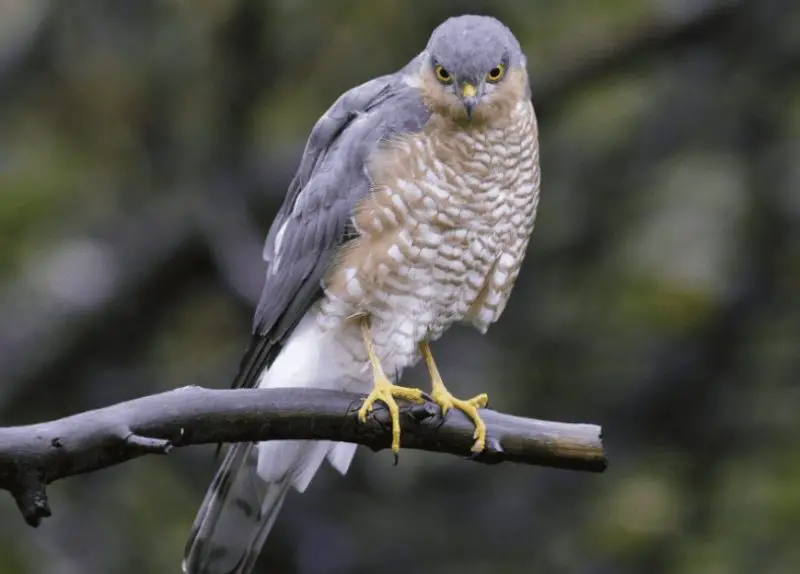
The Cooper’s Hawk is a medium-sized raptor with a long, rounded tail, broad wings, and a sharp, hooked bill. Adults have blue-gray upperparts, reddish barring on the chest, and piercing red eyes, while juveniles are brown above with streaked underparts and yellow eyes. Their long tail, often with a rounded tip and dark bands, is a key identification feature.
Measuring 14.6 to 17.7 inches in length with a wingspan of 24.4 to 35.4 inches, Cooper’s Hawks are agile flyers, adept at weaving through dense woods to chase small birds and mammals. They often hunt by surprise, perching quietly before launching a rapid, direct pursuit. Their hunting skill and speed make them a frequent backyard predator, especially near bird feeders.
In Indiana, Cooper’s Hawks are year-round residents, found in forests, woodlots, and increasingly in suburban areas. They build stick nests high in trees, often reusing the same site year after year.
Turkey Vulture
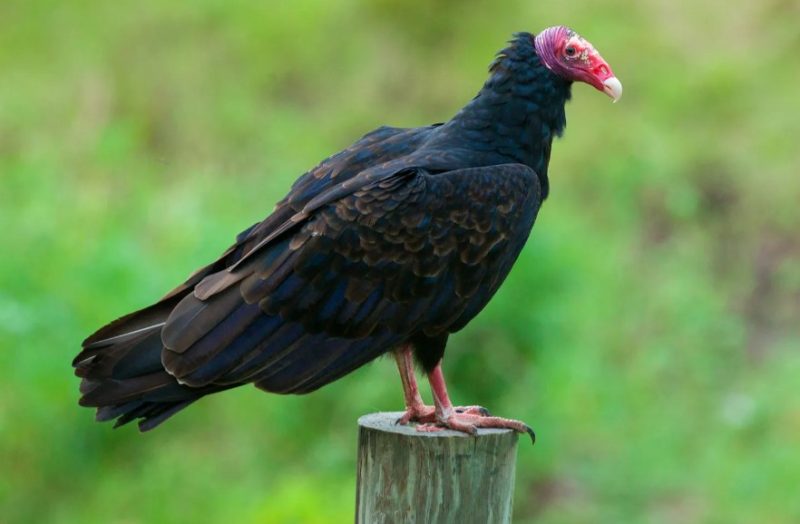
The Turkey Vulture is a large, dark bird with long, broad wings and a small, bare red head. In flight, it holds its wings in a shallow V-shape and rocks gently side-to-side. Its featherless head helps it stay clean when feeding on carrion, its primary food source.
At 25 to 32 inches long with an impressive wingspan of 63 to 72 inches, Turkey Vultures locate carcasses using an excellent sense of smell, rare among birds. They are silent for most of the year, making only hisses and grunts. Their effortless soaring flight allows them to cover vast areas while searching for food.
In Indiana, Turkey Vultures are common from spring through fall, migrating south for the winter. They are most often seen gliding over open countryside, farmland, and roadsides.
Ruby-throated Hummingbird

The Ruby-throated Hummingbird is a tiny, iridescent jewel of a bird. Males have brilliant ruby-red throats, metallic green backs, and white underparts, while females lack the red throat and are more subtly colored. Their long, slender bill is adapted for sipping nectar.
Measuring only 2.8 to 3.5 inches long with a wingspan of 3.1 to 4.3 inches, Ruby-throated Hummingbirds can hover in place and fly backward thanks to rapid wingbeats—up to 53 beats per second. They feed mainly on flower nectar, but also consume small insects and spiders for protein. Their courtship flights are fast and acrobatic.
In Indiana, Ruby-throated Hummingbirds are summer residents, arriving in late April or May and departing by early fall. They breed in woodlands, gardens, and meadows, and readily visit feeders offering sugar water.
Baltimore Oriole
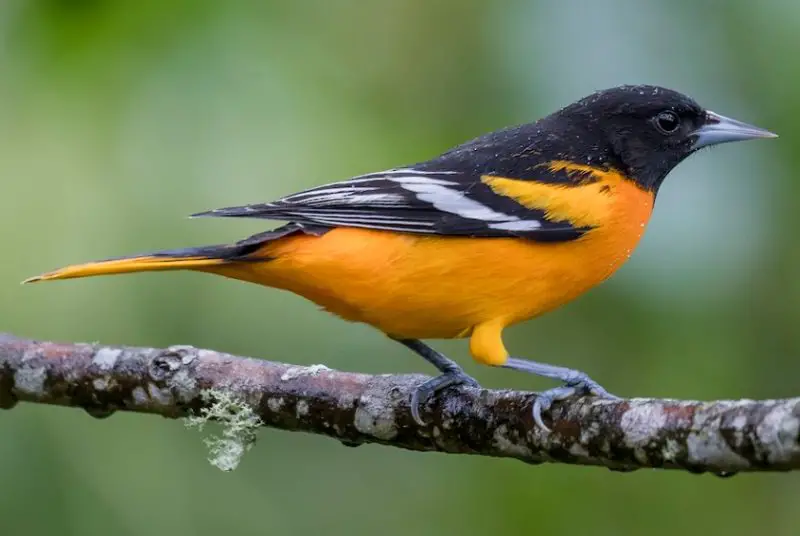
The Baltimore Oriole is a striking songbird with bright orange underparts and black upperparts in males, while females are more yellow-orange with grayish wings. Both sexes have slender bodies, long tails, and sharply pointed bills ideal for eating fruit and insects.
At 6.7 to 7.5 inches in length with a wingspan of 9 to 11.8 inches, Baltimore Orioles are famous for their hanging, woven nests shaped like pouches, suspended from the tips of tree branches. Their flute-like, whistling song and cheerful chatter are common sounds in spring. They feed on insects, ripe fruits, and nectar.
In Indiana, Baltimore Orioles arrive in late spring and are most common in open woodlands, parks, and backyard gardens. They migrate to Central and South America for the winter.
Eastern Meadowlark

The Eastern Meadowlark is a chunky, ground-dwelling songbird with a bright yellow chest marked by a bold black “V,” brown streaked upperparts, and a short tail with white outer feathers. Its flat head and long, straight bill give it a distinctive profile.
Measuring 7.5 to 10.2 inches long with a wingspan of 13.8 to 15.8 inches, Eastern Meadowlarks sing a rich, flute-like whistle that carries far across fields. They forage mainly on the ground, eating insects in summer and seeds in winter. During courtship, males perform short flight displays while singing.
In Indiana, Eastern Meadowlarks are common in grasslands, hayfields, and prairies, especially during the breeding season. Some individuals migrate south for winter, while others remain in the state year-round in areas with sufficient food and cover.
White-throated Sparrow
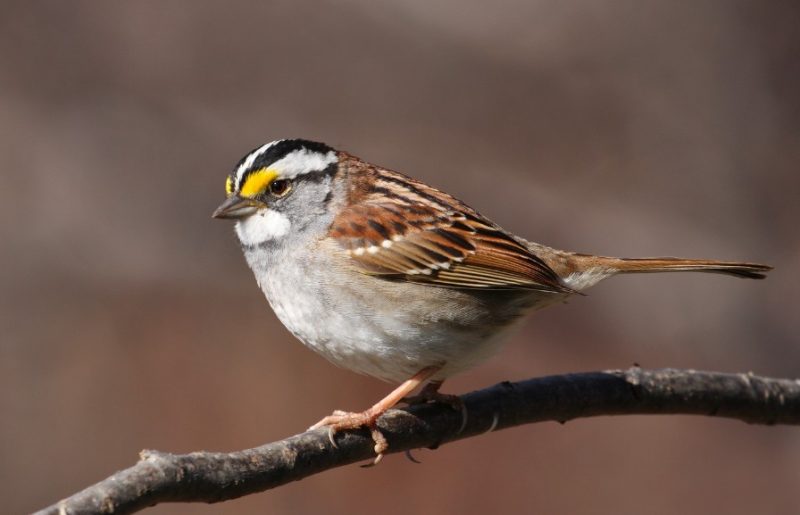
The White-throated Sparrow is a medium-sized sparrow with a crisp white throat patch, a gray breast, and distinctive head stripes that can be either white-and-black or tan-and-brown. A bright yellow spot between the eye and bill adds a splash of color to its otherwise earthy tones.
Measuring 6.3 to 7.1 inches long with a wingspan of 7.9 to 9.1 inches, this sparrow has a clear, whistled song often described as “Old Sam Peabody, Peabody, Peabody.” It feeds mainly on seeds and insects, scratching at the ground with both feet to uncover food. In winter, they frequently visit backyard feeders.
In Indiana, White-throated Sparrows are most common during spring and fall migration, though some overwinter in brushy areas, forest edges, and gardens. They breed in the northern U.S. and Canada before returning south.
Swamp Sparrow
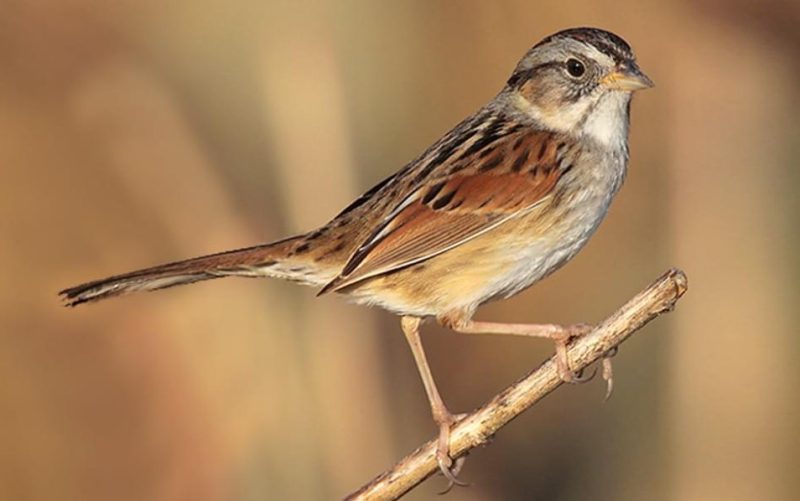
The Swamp Sparrow is a small, secretive bird with a rusty crown, gray face, and rich brown back streaked with black. Its underparts are gray with a hint of buff on the sides, and its short, conical bill is well-suited for seed eating.
At 4.7 to 5.9 inches in length with a wingspan of 7.1 to 7.5 inches, Swamp Sparrows are strong singers, delivering a slow, sweet trill from dense wetland vegetation. They feed on seeds year-round, adding insects and spiders to their diet during summer.
In Indiana, Swamp Sparrows are primarily migrants, passing through in spring and fall, though some stay to breed in marshes and wet meadows. They are also found in similar habitats during their winter stay in southern states.
Pileated Woodpecker
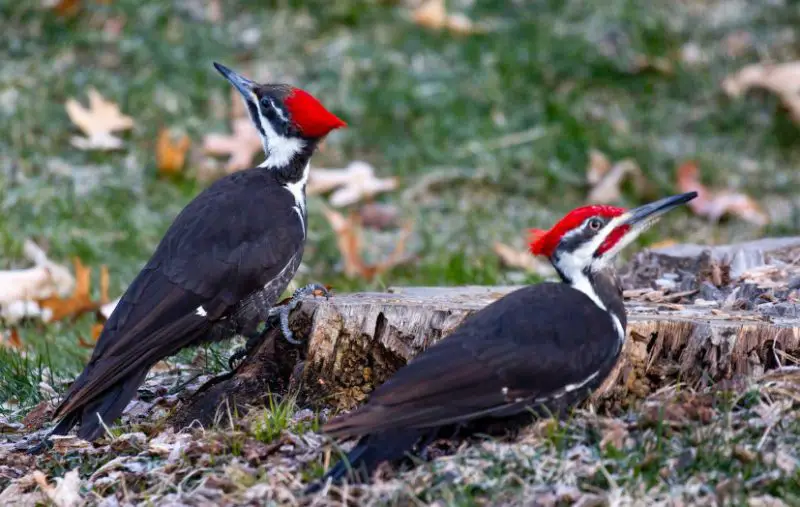
The Pileated Woodpecker is the largest woodpecker in North America, nearly crow-sized, with bold black-and-white plumage and a striking red crest. Males have a red stripe on the cheek, while females do not. Their long chisel-like bill is used to excavate large rectangular holes in search of carpenter ants and beetle larvae.
Measuring 15.8 to 19.3 inches in length with a wingspan of 26 to 29.5 inches, Pileated Woodpeckers have a loud, ringing “cuk-cuk-cuk” call and a powerful drumming sound that resonates through the forest. They play an important ecological role by creating nesting sites for other cavity-nesting species.
In Indiana, Pileated Woodpeckers are year-round residents in mature forests with large trees, often near rivers or swamps. Their dramatic size and loud calls make them one of the most exciting birds to encounter in the wild.
Hairy Woodpecker
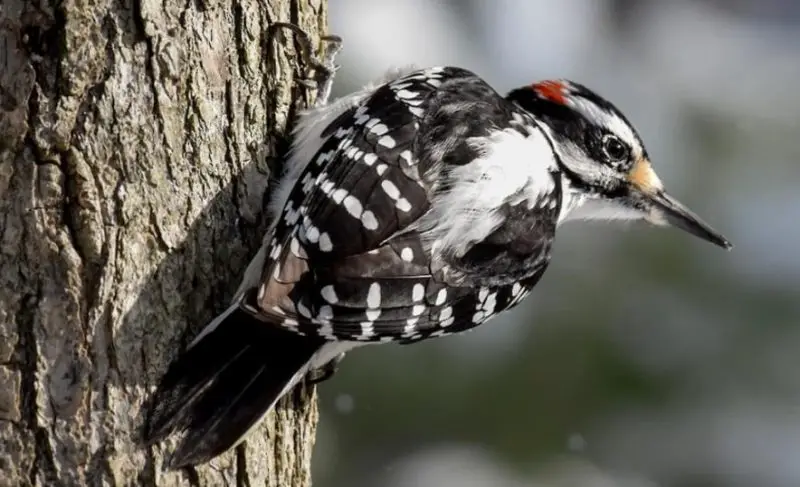
The Hairy Woodpecker is a medium-sized woodpecker with black-and-white checkered wings, a white underside, and a long, straight bill almost the length of its head. Males have a small red patch on the back of the head, while females do not.
At 7.1 to 10.2 inches long with a wingspan of 13 to 16.1 inches, Hairy Woodpeckers forage on tree trunks and branches, probing bark for insects and occasionally eating seeds or suet from feeders. Their sharp “peek” call and steady drumming are distinctive.
In Indiana, Hairy Woodpeckers are year-round residents of forests, parks, and wooded suburban areas. They are often confused with the smaller Downy Woodpecker, but can be distinguished by their larger size and longer bill.
Herring Gull

The Herring Gull is a large, robust gull with light gray upperparts, white head and underparts, and black wingtips with white spots. In breeding season, adults have a bright yellow bill with a red spot near the tip, while juveniles are mottled brown for their first few years.
Measuring 22 to 26 inches long with a wingspan of 53 to 57 inches, Herring Gulls are opportunistic feeders, eating fish, invertebrates, and human food scraps. They are intelligent and adaptable, often seen following fishing boats or scavenging in urban areas.
In Indiana, Herring Gulls are most common in winter, especially along large lakes, rivers, and reservoirs. They breed farther north but migrate south in large flocks during the colder months.
Canada Goose
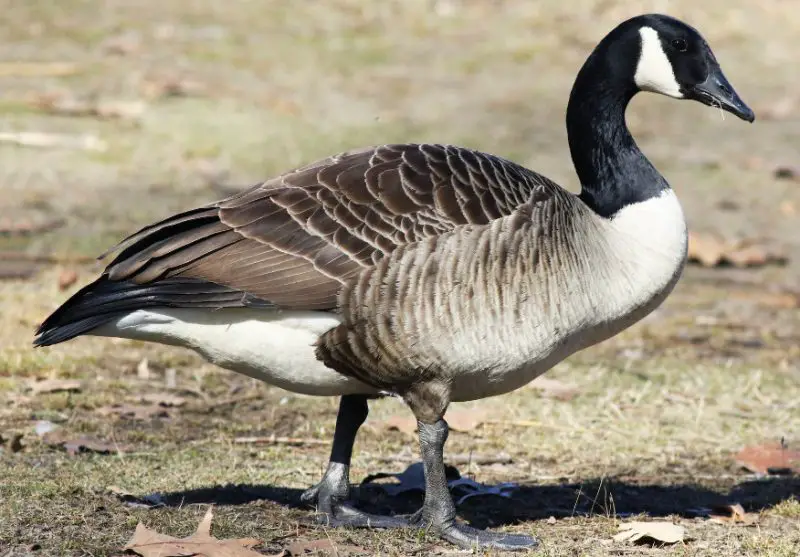
The Canada Goose is a large waterfowl species with a black head and neck, white cheek patches, and a brownish-gray body. Its long neck and loud, honking calls make it one of the most recognizable birds in North America.
At 30 to 43 inches in length with a wingspan of 50 to 66 inches, Canada Geese are strong fliers and can migrate thousands of miles, though many populations now remain in the same area year-round. They feed on grasses, grains, and aquatic plants, often grazing in fields and parks.
In Indiana, Canada Geese are abundant year-round, nesting near ponds, lakes, and rivers. Migratory flocks pass through in spring and fall, joining the local residents in large, noisy gatherings.
FAQs about Common Birds in Indiana
What are some of the most common birds found in Indiana?
Indiana is home to a variety of common birds including the Northern Cardinal, American Robin, Mourning Dove, Blue Jay, and American Goldfinch. These species are frequently seen across urban, suburban, and rural areas throughout the state.
When is the best time to see common birds in Indiana?
The best time for birdwatching in Indiana is during the spring and fall migration seasons when many species pass through the state. However, many common birds such as the Northern Cardinal and Blue Jay can be seen year-round.
Where can I go birdwatching in Indiana?
Popular birdwatching spots in Indiana include state parks, wildlife refuges, wetlands, and nature preserves such as the Indiana Dunes National Park, Goose Pond Fish and Wildlife Area, and Shades State Park. These locations offer diverse habitats attracting a wide range of bird species.
What do common Indiana birds eat?
Most common birds in Indiana have varied diets including seeds, insects, fruits, and nectar. For example, American Robins primarily feed on earthworms and insects, while American Goldfinches prefer seeds. Providing bird feeders with sunflower seeds, millet, or suet can attract many species to your yard.
How can I attract common birds to my backyard in Indiana?
To attract common birds, provide a combination of food, water, and shelter. Plant native shrubs and trees for natural cover, use bird feeders filled with seeds suitable for local species, and include a birdbath or shallow water source. Avoid using pesticides to maintain a healthy insect population for insect-eating birds.
Are there any rare or endangered birds in Indiana?
While many birds in Indiana are common and widespread, some species are considered rare or threatened due to habitat loss. For example, the Cerulean Warbler and the Indiana Bat (though not a bird) are species of concern. Conservation efforts continue to protect these and other vulnerable species.
Do common birds in Indiana migrate?
Yes, many common birds in Indiana migrate seasonally. Species like the Ruby-throated Hummingbird and Eastern Bluebird migrate south for the winter and return in spring, while others like the Northern Cardinal are year-round residents. Migration patterns depend on food availability and weather conditions.
What is the best way to identify birds in Indiana?
Bird identification can be improved by learning key features such as size, color patterns, calls, and behavior. Using a field guide, bird identification app, or joining local birdwatching groups can enhance your skills. Observing birds with binoculars and taking notes on their habits also helps.

